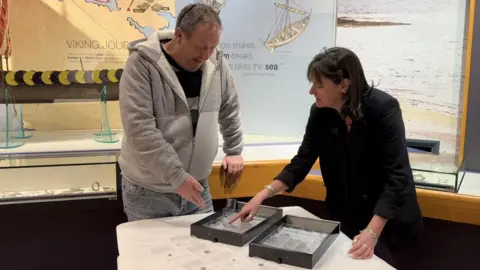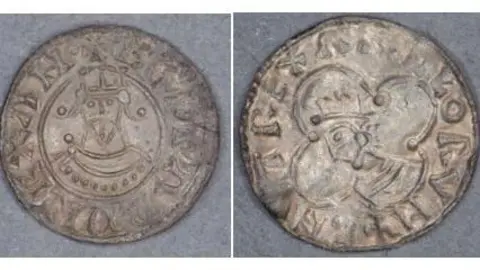Viking age coins declared treasure go on display
 BBC
BBCA hoard of Viking age silver coins found in a field by two metal detectorists have gone on display at Isle of Man's national museum for the next two weeks.
The 1,000-year-old "bank account" of 36 silver coins was discovered earlier this year by David O’Hare and John Crowe and legally declared treasure on Monday.
Mr O’Hare, who took up the hobby of metal detecting 20 years ago, said finding the coins was like all his "Christmases and birthdays come together".
The coins will remain on display at the Manx Museum in Douglas until 13 October.
 MNH
MNHThe artefacts were thought to have been buried in three tranches, with the third added to the hoard in1070.
Many different mints are represented on the coins, including some in Ireland, York, Lincoln and Hastings.
Manx National Heritage curator of archaeology Alison Fox said the find represented "a really interesting snapshot of the Viking age where people were coming to the Isle of Man, bringing in currency from lots of different places, trading and using the island as a financial hub".
This particular hoard was of interest as it appeared to have been used as a "savings account", with coins being added and removed from it over four decades, Ms Fox said.

Mr O'Hare has been metal detecting in partnership with Mr Crowe for the past 15 years, with the pair securing permission from the landowner to search the field.
He said making the find was "like winning the lottery", because detectorists could "go 40 or 50 years without finding something like that".
"And we found a few of them, which is even better," he added.
Ms Fox said that the finders had done "exactly the right thing" by "resisting the urge to clean the coins", which meant that valuable information was not lost.
Leaving the soil intact meant substances such as lead deposits or pieces of textile, which might indicate what kind of container the artefacts had been buried in, had been retained.
Why not follow BBC Isle of Man on Facebook and X? You can also send story ideas to [email protected]
